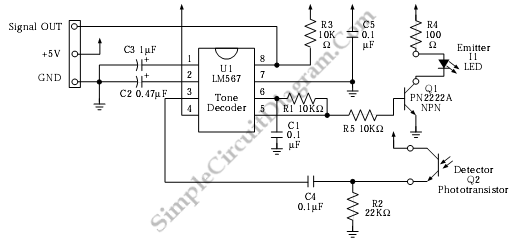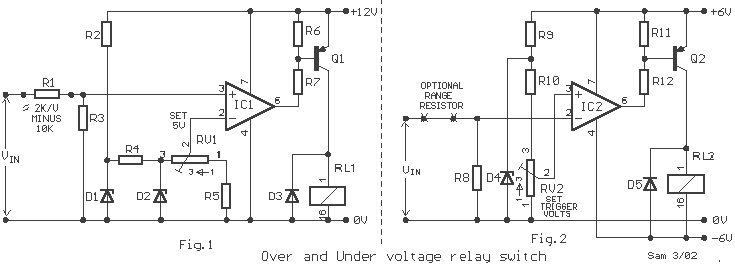
Photoelectric smoke detector

The LED predriver output pulses an external transistor, which subsequently activates the infrared light-emitting diode (IR LED) at a very low duty cycle. The desired pulse period of the IR LED is determined by the value of an external timing resistor. Smoke sensitivity can be adjusted using a trimmer resistor that varies the pulse width of the IR LED. A silicon photovoltaic cell serves as the light sensing element, maintained at near zero bias to minimize leakage currents. The circuit is capable of detecting signals as low as 1 mV and can generate an alarm. The pulse repetition rate of the IR LED increases upon smoke detection.
The described circuit operates as a smoke detection system utilizing a low-power infrared LED and a silicon photovoltaic cell for light sensing. The LED predriver serves as the control mechanism, producing a pulsed output that drives an external transistor. This arrangement allows the IR LED to emit light in pulses, which is critical for maintaining low power consumption while ensuring effective smoke detection.
The timing of the IR LED pulses is governed by an external timing resistor, which sets the pulse period. This allows for customization of the circuit's response time based on the specific application requirements. The trimmer resistor provides further flexibility by enabling adjustments to the pulse width, which directly affects the sensitivity of the smoke detection mechanism. By varying the pulse width, the circuit can be fine-tuned to respond to different levels of smoke density, enhancing its performance in various environments.
The light sensing element, a silicon photovoltaic cell, is critical to the operation of this circuit. By maintaining the cell at near zero bias, the design minimizes leakage currents that could otherwise lead to false positives or reduced sensitivity. This configuration allows the system to detect even the smallest changes in light intensity caused by smoke particles, with a sensitivity threshold as low as 1 mV.
Upon detecting smoke, the circuit triggers an alarm and increases the pulse repetition rate of the IR LED. This change in pulse frequency serves as an indication of smoke presence, enhancing the system's responsiveness and reliability. Overall, this smoke detection circuit combines efficient light emission, precise timing, and sensitive detection to provide an effective solution for smoke monitoring applications.The LED predriver output pulses an external transistor which in turn, switches on the infrared light emitting diode at a very low duty cycle. The desired IR LED pulse period is determined by the value of the external timing resistor. The Smoke Sensitivity is adjustable through a trimmer resistor which varies the IR LED pulse width. The light sensing element is a silicon photovoltaic cell which is held at near zero bias to minimize leakage currents
The circuit can detect signals as low as 1 mV and generate an alarm. The IR LED pulse repetition rate increases when smoke is detected. 🔗 External reference
The described circuit operates as a smoke detection system utilizing a low-power infrared LED and a silicon photovoltaic cell for light sensing. The LED predriver serves as the control mechanism, producing a pulsed output that drives an external transistor. This arrangement allows the IR LED to emit light in pulses, which is critical for maintaining low power consumption while ensuring effective smoke detection.
The timing of the IR LED pulses is governed by an external timing resistor, which sets the pulse period. This allows for customization of the circuit's response time based on the specific application requirements. The trimmer resistor provides further flexibility by enabling adjustments to the pulse width, which directly affects the sensitivity of the smoke detection mechanism. By varying the pulse width, the circuit can be fine-tuned to respond to different levels of smoke density, enhancing its performance in various environments.
The light sensing element, a silicon photovoltaic cell, is critical to the operation of this circuit. By maintaining the cell at near zero bias, the design minimizes leakage currents that could otherwise lead to false positives or reduced sensitivity. This configuration allows the system to detect even the smallest changes in light intensity caused by smoke particles, with a sensitivity threshold as low as 1 mV.
Upon detecting smoke, the circuit triggers an alarm and increases the pulse repetition rate of the IR LED. This change in pulse frequency serves as an indication of smoke presence, enhancing the system's responsiveness and reliability. Overall, this smoke detection circuit combines efficient light emission, precise timing, and sensitive detection to provide an effective solution for smoke monitoring applications.The LED predriver output pulses an external transistor which in turn, switches on the infrared light emitting diode at a very low duty cycle. The desired IR LED pulse period is determined by the value of the external timing resistor. The Smoke Sensitivity is adjustable through a trimmer resistor which varies the IR LED pulse width. The light sensing element is a silicon photovoltaic cell which is held at near zero bias to minimize leakage currents
The circuit can detect signals as low as 1 mV and generate an alarm. The IR LED pulse repetition rate increases when smoke is detected. 🔗 External reference





